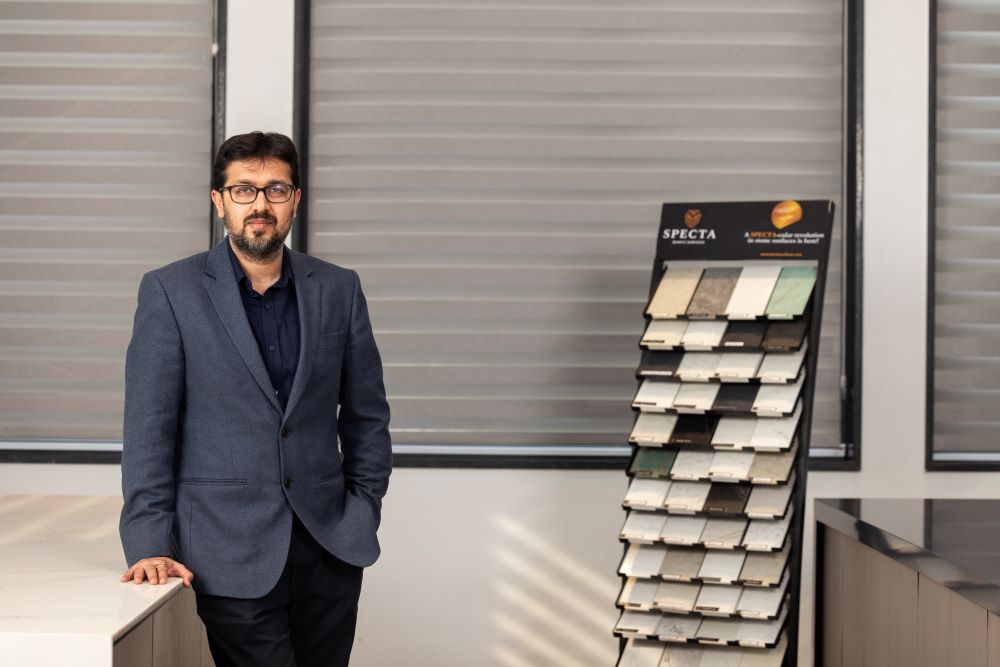By Ankit Jain, Founder, Specta Quartz Surfaces
A new wave of affluence and aspiration is transforming India’s tier-2 and tier-3 cities, reshaping not just real estate but also interior design and material preferences. Luxury surfaces, once confined to metropolitan homes in Mumbai, Delhi and Bengaluru, are now finding a strong foothold in emerging markets like Bhubaneswar, Kanpur, Indore, Karnal, Pune, Nagpur and Ayodhya, among many others. As premium real estate projects expand across these cities, the demand for high-end materials such as engineered quartz is growing in tandem, redefining interior aesthetics and functional sophistication.
Luxury real estate expansion: The catalyst for change
According to a recent ANAROCK report, luxury housing (units priced above INR 1.5 crore) now accounts for nearly 17% of all new residential launches in India as of 2024, with non-metro cities contributing 12% to this segment. Leading developers such as Adani Realty, Godrej Projects, and Brigade Group are increasingly expanding into these emerging markets, signifying a growing appetite for aspirational living beyond metros. For instance, Punjab, once primarily renowned for manufacturing and trade, is undergoing a transformation, emerging as a prime destination for luxury residences, high-end retail, and top-tier commercial developments. Developments like The Wilton and ‘M Square’ by Malhotra Realty exemplify this shift, offering amenities such as integrated five-star hospitality, high-end retail spaces, and lush green landscapes.
As these geographies witness a surge in luxury real estate projects, the demand for bespoke interiors is evolving in parallel. Homeowners are seeking opulent yet functional living spaces with an increased preference for ultra-modern kitchens, designer wardrobes, and spa-inspired bathrooms. This transition has propelled luxury surface materials, particularly quartz, to the forefront as an ideal choice for high-end interiors.
Consumer exposure shaping market trends
Today’s affluent homeowners in tier-2 and tier-3 cities are more design-conscious than ever, fueled by increased exposure to global design trends through social media, films, travel and influencer-driven content. According to a recent CREDAI-Liases Foras report covering 60 Indian cities, sales in the ultra-luxury segment (INR 2 crore and above) in tier-2 and tier–3 cities surged by 73% in 2024 alone. This spike reflects a growing willingness to invest in luxury living and build pinterest-inspired dream homes.
However, while disposable incomes and aspirations are on the rise, it is to be noted that consumer awareness around higher-quality natural stone alternatives—like engineered quartz and sintered stone—is still evolving in these markets. Many homeowners continue to opt for traditional options like granite and marble. Yet the shift is accelerating as consumers are becoming aware of the ability of engineered stones to replicate natural stone patterns while offering superior durability, stain resistance and hygiene. An Increasing number of homeowners in Jaipur, Lucknow and Coimbatore, for instance, are integrating quartz into contemporary European-style kitchens, spa-inspired bathrooms, and multifunctional living areas that blend modern minimalism with local cultural influences.
Additionally, designers in these cities are leveraging the adaptability of quartz to create spaces that harmonise global aesthetics with regional heritage—combining handcrafted woodwork with sleek quartz countertops, or pairing intricate Jaali designs with contemporary finishes. As a result, the demand is shifting toward versatile, high-performance materials that cater to India’s diverse and evolving design sensibilities.
Sustainability & safety: Growing priorities for consumers
As luxury consumption patterns evolve, homebuyers are prioritising attributes like sustainability and health-conscious design. Premium quartz manufacturers are responding proactively to these expectations.
Specta, for instance, is catering to these evolving consumer preferences by acquiring certifications such as NSF (ensuring its surfaces are safe for food preparation) and Greenguard (guaranteeing low chemical emissions). It is actively introducing collections inspired by local aesthetics while enhancing manufacturing processes to ensure sustainability.
The future of luxury surfaces in emerging markets
With tier-2 and tier-3 cities redefining luxury living, the luxury surfaces industry is poised for an era of rapid expansion. The rising synergy between real estate development and high-end interior solutions will shape consumer behavior, drive innovation and create new market opportunities.
Brands that invest in consumer education, localised product design and experience-driven marketing will emerge as industry leaders. Innovation both in manufacturing practices and product designs is being rewarded by buyers. As these markets mature and infrastructure improves, they will play a defining role in setting the next benchmarks for India’s luxury surfaces industry—ushering in a future where aspirational living extends well beyond metropolitan borders.


